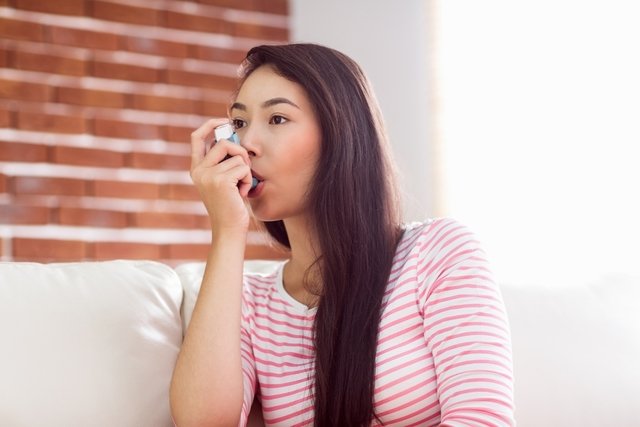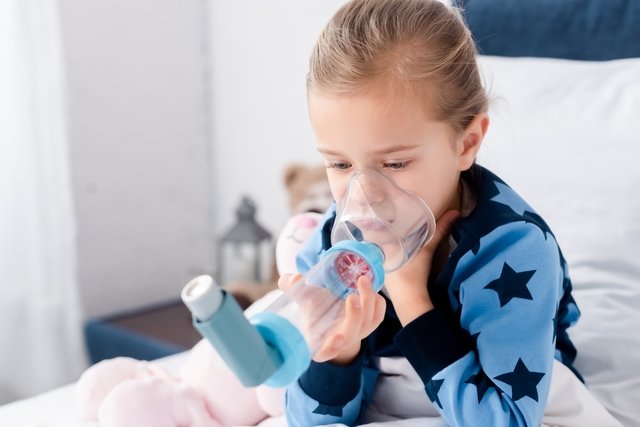Asthma inhalers are indicated for the treatment and management of asthma. They should be used as prescribed by a doctor.
Some of the most commonly used asthma inhalers are short-acting and long-acting bronchodilators, inhaled corticosteroids and combination puffers.
To use an inhaler for asthma correctly, you should sit or stand and position your head slightly tilted upwards so that the inhaled powder goes directly into the airways and does not accumulate on the roof of the mouth, throat or tongue.

Types of inhalers
There are two main types of asthma inhalers: those with bronchodilators to help relieve symptoms, and those with corticosteroids to treat chronic inflammation of the bronchi.
The type of inhaler to use should be prescribed by your family doctor or lung specialist, depending on the intensity of the symptoms and the severity of the inflammation.
How to use
Here's how to use the asthma inhaler according to age:
1. Adults and adolescents
The step-by-step instructions for adults to use the asthma inhaler correctly are:
- Exhale deeply to release all the air from the lungs;
- Place the inhaler in your mouth, between your teeth and close your lips;
- Press down on the inhaler while breathing deeply through your mouth, filling your lungs with air;
- Remove the inhaler from your mouth and stop breathing for 10 seconds or more;
- Rinse your mouth, without swallowing, so that traces of the medicine don't accumulate in your mouth or stomach.
If you need to use the inhaler twice in a row, you should wait about 30 seconds and then repeat the steps starting with the first step.
The amount of powder inhaled is generally not noticeable, as it has no taste or aroma. To check that the dose has been used correctly, you should look at the dose counter on the device itself.
Usually, treatment with an inhaler is also accompanied by the use of other medicines, especially to reduce the chances of having a crisis. Learn more about the asthma medication your doctor may prescribe to manage this condition.
2. Children
Children over 2 years of age who use mist spray puffers can use spacers, which are devices that can be bought in pharmacies or online. These spacers serve to ensure that the exact dose of medication reaches the child's lungs.
To use the asthma inhaler with a spacer, it is recommended to:
- Place the valve on the spacer.
- Shake the asthma inhaler vigorously, with the nozzle downwards, 6 to 8 times.
- Insert the inhaler into the spacer.
- Ask the child to let the air out of their lungs;
- Place the spacer in the child's mouth, between their teeth and ask them to close their lips;
- Fire the spray bottle and wait for the child to breathe through their mouth (through the spacer) 6 to 8 times slowly and deeply. Covering the nose can help the child not to breathe through their nose.
- Remove the spacer from the mouth;
- Rinse the mouth and teeth, then spit out the water.
If you need to use the inhaler twice in a row, wait about 30 seconds and then repeat the steps starting with step 4.
To keep the spacer clean, wash the inside only with water and leave it to dry, without wiping it with a towel or dishcloth, so that no residue remains inside. It is also advisable to avoid using plastic spacers because plastic attracts the drug molecules to it, so the drug can become trapped in its walls and not reach the lungs.

3. Babies
To use the asthma inhaler on babies and young children, up to 2 years old, you can use spacers that are shaped like a nebulizer and wrap around the nose and mouth. This can also be used for toddlers who are unable to coordinate the movement of inhaling on command.
To use the asthma inhaler on babies, you should:
- Place the mask on the mouthpiece of the spacer;
- Shake the inhaler vigorously, with the mouthpiece downwards, for a few seconds;
- Insert the asthma inhaler into the spacer;
- Sit down and place the baby on one of your legs;
- Place the mask on the baby's face, covering the nose and mouth;
- Spray the inhaler once and wait for the baby to inhale about 5 to 10 times through the mask;
- Remove the mask from the baby's face;
- Clean the baby's mouth with a clean wet cloth;
- Wash the mask and spacer with water and mild soap, leaving it to air dry.
If you need to use the inhaler again, wait 30 seconds and start again with step 2.
Frequently asked questions
These are some of the most common doubts that people may have about using asthma inhalers:
1. Are inhalers addictive?
Asthma inhalers are not addictive. They should be used daily or as prescribed, with some people requiring several uses per day to relieve asthma symptoms. More frequent use is usually recommended for asthma attacks or flare-ups.
If you find yourself using your rescue inhaler more than 4 times a day, you should see your doctor or lung specialist for reassessment. The doctor may order more testing, and consider medication alternatives.
2. Are asthma inhalers bad for your heart?
Some asthma inhalers can cause cardiac arrhythmia immediately after use. However, this is not a dangerous situation and does not reduce the number of years an asthmatic can live.
The correct use of the asthma inhaler is essential to facilitate the arrival of air in the lungs, and lack of use or improper use can cause suffocation, which is a serious medical emergency.
3. Can pregnant women use asthma inhaler?
Yes, pregnant women can use the same asthma inhalers they used before becoming pregnant. Use should be monitored by the obstetrician and/or lung specialist.
